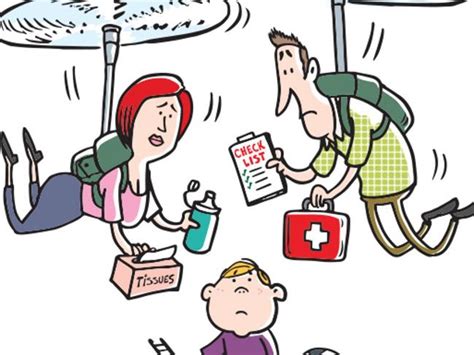
Tales of classroom chaos and unexpected student behavior are revealed in a collection of anecdotes shared by teachers, offering parents insights into the daily realities of elementary school life, spanning bizarre lunch choices to surprisingly philosophical musings from young children.
Elementary school teachers have lifted the veil on the often-unpredictable world of young children in the classroom, sharing a series of stories that range from humorous to perplexing and occasionally heartwarming. These anecdotes, compiled from educators across various schools, offer parents a glimpse into the unfiltered thoughts, actions, and behaviors that unfold behind the closed doors of elementary classrooms every day. The shared experiences highlight the developmental stage of children, their unique approaches to problem-solving, and the challenges and rewards of shaping young minds.
Unconventional Lunch Choices and Culinary Curiosity
One recurring theme in the teachers’ stories is the often-bizarre and seemingly inexplicable food choices made by young children. “I once had a student who brought a single, raw carrot stick for lunch every day for an entire month,” one teacher recounted. “When I asked him about it, he simply shrugged and said, ‘I like carrots.'” Another teacher shared an equally puzzling experience: “A little girl brought a Ziploc bag full of uncooked rice to school, and when I asked her what it was for, she told me it was her ‘snack.'”
These anecdotes serve as a reminder that children’s palates and preferences are still developing, and their understanding of what constitutes a “normal” meal can be vastly different from that of adults. According to pediatric nutritionists, such unusual food choices are often a result of children’s limited exposure to a variety of foods, as well as their natural inclination to experiment and test boundaries. It’s not uncommon for children to fixate on a particular food for a period of time, only to move on to something else entirely. The teachers’ stories underscore the importance of parents fostering a healthy and balanced diet for their children, while also respecting their individual preferences and allowing them to explore different tastes and textures.
The stories also highlight the challenges that teachers face in ensuring that all students have access to nutritious meals. While many schools offer free or reduced-price lunch programs, some students may still come to school with inadequate or unhealthy food. Teachers often find themselves in the position of supplementing students’ lunches with snacks or even providing them with full meals out of their own pockets.
Philosophical Musings and Existential Questions
Beyond the realm of quirky food choices, the teachers’ stories also reveal the surprising depth and complexity of children’s thoughts. One teacher shared a story about a first-grader who approached her during recess with a profound question: “If the sky is blue, why isn’t the Earth blue too?” The teacher admitted that she was initially taken aback by the question but recognized it as an opportunity to engage the child in a discussion about science and the nature of our planet.
Another teacher recounted a similar experience with a group of kindergartners who were discussing the concept of death. “One little boy declared that when you die, you turn into a star,” the teacher said. “Another girl countered that you become a ghost and haunt your house. It was fascinating to hear their different perspectives and how they were trying to make sense of something so abstract.”
These anecdotes highlight the innate curiosity and philosophical inclinations of young children. Despite their limited life experience, they are constantly grappling with big questions about the world around them, their place in it, and the mysteries of life and death. Teachers play a crucial role in fostering this curiosity and providing children with a safe space to explore these complex ideas.
Child psychologists emphasize the importance of encouraging children to ask questions and to express their thoughts and feelings, even if they seem illogical or nonsensical. By engaging with children’s questions and providing them with age-appropriate answers, parents and teachers can help them develop critical thinking skills and a deeper understanding of the world.
Classroom Chaos and Behavioral Quirks
Of course, not all of the teachers’ stories are heartwarming or philosophical. Many of them involve instances of classroom chaos, behavioral quirks, and the occasional minor crisis. “I once had a student who decided to give himself a haircut during math class,” one teacher said. “He managed to snip off a huge chunk of his hair before I could stop him.” Another teacher shared a similar story about a student who decided to paint his face with glue and glitter during art class.
These anecdotes serve as a reminder that young children are still learning to control their impulses and to navigate the social norms of the classroom. They are prone to making mistakes, engaging in attention-seeking behaviors, and occasionally acting out in ways that can be frustrating for teachers.
Behavioral specialists explain that many of these behaviors are a normal part of child development. Children are still learning to regulate their emotions, to understand the consequences of their actions, and to cooperate with others. Teachers play a crucial role in helping children develop these skills by setting clear expectations, providing consistent discipline, and creating a supportive and nurturing classroom environment.
The stories also highlight the importance of communication between teachers and parents. When a child is exhibiting behavioral problems in the classroom, it is essential for teachers to work with parents to identify the underlying causes of the behavior and to develop a plan for addressing it. This may involve implementing specific strategies in the classroom, such as positive reinforcement or time-outs, or it may require the involvement of a school counselor or other mental health professional.
The Importance of Patience, Understanding, and a Sense of Humor
Ultimately, the teachers’ stories underscore the importance of patience, understanding, and a sense of humor when dealing with young children. Teaching elementary school is a challenging but rewarding profession that requires a unique combination of skills and qualities. Teachers must be able to manage a classroom full of energetic and unpredictable children, to deliver engaging lessons, and to provide individualized support to students with diverse needs.
They must also be able to navigate the complex social and emotional dynamics of the classroom, to deal with behavioral problems, and to communicate effectively with parents. And perhaps most importantly, they must be able to maintain a sense of humor and to find joy in the everyday moments of teaching.
The stories shared by these teachers offer a valuable reminder that children are not simply miniature adults. They are complex and developing individuals who are still learning to navigate the world. By understanding their unique perspectives, their challenges, and their quirks, parents and teachers can work together to create a supportive and nurturing environment that allows them to thrive. The article serves as a testament to the dedication and resilience of elementary school teachers, who play a vital role in shaping the lives of young children. Their stories offer a glimpse into the often-unseen world of elementary school and provide parents with valuable insights into the minds and hearts of their children.
The anecdotes provide a lighthearted yet insightful look into the world of elementary school, showcasing the unpredictable nature of children and the dedication of their teachers. They are a reminder that childhood is a time of exploration, discovery, and occasional mishaps, and that with patience, understanding, and a good sense of humor, both parents and teachers can help children navigate the challenges and joys of growing up. The shared experiences offer valuable lessons for parents, emphasizing the importance of open communication with teachers, fostering a supportive learning environment at home, and appreciating the unique perspectives of their children. These seemingly small moments in the classroom can have a lasting impact on a child’s development, shaping their character and preparing them for the future.
Expanded Details and Context:
The collection of anecdotes from teachers paints a vivid picture of the elementary school experience, highlighting not just the academic aspects, but also the social, emotional, and developmental milestones that children encounter during these formative years. Beyond the specific stories mentioned above, several other themes emerge from the shared experiences.
Social Dynamics and Peer Interactions:
Elementary school is often the first significant social environment for children outside of their families. It is a place where they learn to navigate peer relationships, to cooperate with others, to resolve conflicts, and to develop a sense of belonging. The teachers’ stories often touch upon the complexities of these social dynamics.
For example, one teacher shared a story about a group of students who formed a “secret club” that excluded certain classmates. The teacher used this as an opportunity to discuss the importance of inclusivity and empathy, and to help the students understand the impact of their actions on others. Another teacher recounted an incident in which two students got into a heated argument over a toy during recess. The teacher intervened and helped the students to communicate their feelings and to find a compromise.
These anecdotes illustrate the challenges that children face in navigating social situations and the role that teachers play in guiding them through these experiences. Teachers often act as mediators, facilitators, and role models, helping children to develop the social skills and emotional intelligence that they need to succeed in life.
Creativity and Imagination:
Elementary school is also a time of great creativity and imagination. Children are naturally curious and imaginative, and they often express themselves through art, music, drama, and storytelling. The teachers’ stories often highlight the unique and unexpected ways in which children express their creativity.
One teacher shared a story about a student who built a miniature castle out of construction paper during free time. The castle was incredibly detailed and intricate, and the teacher was amazed by the child’s creativity and attention to detail. Another teacher recounted an incident in which a group of students put on an impromptu play during recess. The play was completely unscripted and improvised, and the teacher was impressed by the students’ ability to work together and to create a story on the spot.
These anecdotes illustrate the importance of fostering creativity and imagination in the classroom. Teachers can provide children with opportunities to express themselves through various art forms, to engage in imaginative play, and to develop their storytelling skills. By nurturing creativity and imagination, teachers can help children to become more innovative, resourceful, and confident.
Challenges and Frustrations:
While the teachers’ stories often highlight the joys and rewards of teaching, they also acknowledge the challenges and frustrations that come with the profession. Teachers face a wide range of challenges, including large class sizes, limited resources, diverse student needs, and increasing pressure to meet standardized testing requirements.
One teacher shared a story about a student who was struggling with a learning disability. The teacher spent countless hours working with the student individually, providing extra support and encouragement. However, despite the teacher’s best efforts, the student continued to struggle. The teacher admitted that she felt frustrated and discouraged, but she refused to give up on the student.
Another teacher recounted an incident in which she had to deal with a difficult and uncooperative parent. The parent was constantly complaining about the teacher’s teaching methods and refusing to support her efforts to discipline the child. The teacher found the situation incredibly stressful and draining.
These anecdotes illustrate the challenges that teachers face on a daily basis. They are a reminder that teaching is not always easy or glamorous, but it is a profession that requires dedication, resilience, and a strong commitment to helping children succeed.
The Enduring Impact of Teachers:
Despite the challenges and frustrations, the teachers’ stories ultimately convey a sense of optimism and hope. They highlight the enduring impact that teachers can have on the lives of their students. Teachers are not just instructors; they are mentors, role models, and caregivers. They provide children with a safe and supportive environment in which to learn, grow, and develop.
One teacher shared a story about a former student who contacted her years later to thank her for her support and encouragement. The student said that the teacher had made a profound impact on her life and had helped her to achieve her goals. Another teacher recounted an incident in which she received a heartfelt letter from a parent thanking her for her dedication to her child. The parent said that the teacher had gone above and beyond to help her child succeed and that she was eternally grateful.
These anecdotes illustrate the lasting impact that teachers can have on the lives of their students. They are a reminder that teaching is a profession that truly matters and that teachers have the power to make a difference in the world. The seemingly small acts of kindness, encouragement, and support that teachers provide can have a profound impact on a child’s life, shaping their future and helping them to reach their full potential. The article and its compilation of stories serves as a tribute to the dedication, compassion, and unwavering commitment of elementary school teachers everywhere.
The Role of Parental Involvement:
The collected anecdotes also implicitly underscore the importance of parental involvement in a child’s education. While teachers play a critical role in the classroom, the support and engagement of parents at home can significantly enhance a child’s learning experience. Open communication between teachers and parents is vital for addressing any academic or behavioral issues that may arise. Parents can reinforce learning at home by providing a supportive environment, helping with homework, and encouraging a love of reading. Furthermore, active participation in school events and activities demonstrates to children the value that their parents place on education. A collaborative partnership between teachers and parents creates a holistic support system that fosters a child’s academic, social, and emotional growth. The shared stories emphasize that a child’s success is a joint effort, requiring the combined dedication and commitment of both educators and parents.
The Evolution of Childhood and Education:
The anecdotes, when viewed collectively, also provide a glimpse into the evolving landscape of childhood and education. Today’s elementary school classrooms are increasingly diverse, reflecting a wide range of cultural backgrounds, learning styles, and individual needs. Teachers must adapt their teaching methods to accommodate these differences and create an inclusive learning environment for all students. Technology is also playing an increasingly prominent role in education, with computers, tablets, and interactive whiteboards becoming commonplace in many classrooms. While technology can offer valuable learning tools, it also presents new challenges, such as managing screen time and addressing issues of digital literacy. Furthermore, societal changes, such as increased screen time and changing family structures, have impacted the way children learn and behave. Teachers must be aware of these trends and adapt their approaches accordingly. The anecdotes serve as a reminder that education is a dynamic and ever-changing field, requiring teachers to be lifelong learners and to embrace innovation in their practice.
FAQ Section:
Q1: What are the main themes highlighted in the teachers’ shared stories?
A1: The main themes include unconventional lunch choices and culinary curiosity among children, philosophical musings and existential questions pondered by young minds, instances of classroom chaos and behavioral quirks, the importance of patience and understanding in dealing with children, the social dynamics of peer interactions, the creativity and imagination displayed by students, the challenges and frustrations faced by teachers, and the enduring impact teachers have on their students’ lives.
Q2: How do the anecdotes emphasize the role of parental involvement in a child’s education?
A2: The anecdotes implicitly underscore the importance of parental involvement through open communication with teachers, creating a supportive learning environment at home, assisting with homework, fostering a love of reading, and actively participating in school events. This collaboration forms a holistic support system for a child’s academic, social, and emotional growth.
Q3: What challenges do elementary school teachers face, as revealed in the shared stories?
A3: Teachers face challenges such as large class sizes, limited resources, diverse student needs including learning disabilities, increasing pressure to meet standardized testing requirements, dealing with difficult or uncooperative parents, and managing classroom chaos and behavioral issues.
Q4: How do teachers foster creativity and imagination in the classroom, according to the anecdotes?
A4: Teachers foster creativity and imagination by providing opportunities for children to express themselves through various art forms, engaging in imaginative play, developing storytelling skills, and encouraging innovative thinking.
Q5: What is the overall message conveyed by the collection of teachers’ stories?
A5: The overall message conveys the dedication, compassion, and unwavering commitment of elementary school teachers, highlighting their vital role in shaping the lives of young children. The stories emphasize the importance of patience, understanding, and a sense of humor when dealing with children, while also underscoring the significance of parental involvement and the ever-evolving landscape of childhood and education. The collection ultimately serves as a tribute to the enduring impact teachers have on their students, shaping their future and helping them to reach their full potential.









